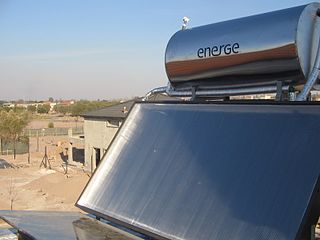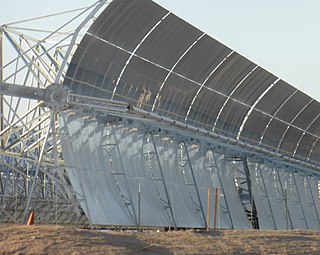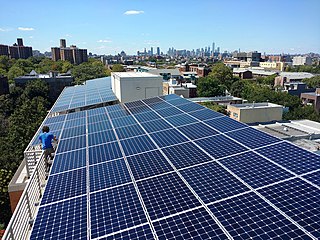
Solar thermal energy (STE) is a form of energy and a technology for harnessing solar energy to generate thermal energy for use in industry, and in the residential and commercial sectors. Solar thermal collectors are classified by the United States Energy Information Administration as low-, medium-, or high-temperature collectors. Low-temperature collectors are generally unglazed and used to heat swimming pools or to heat ventilation air. Medium-temperature collectors are also usually flat plates but are used for heating water or air for residential and commercial use.

A parabolic trough collector (PTC) is a type of solar thermal collector that is straight in one dimension and curved as a parabola in the other two, lined with a polished metal mirror. The sunlight which enters the mirror parallel to its plane of symmetry is focused along the focal line, where objects are positioned that are intended to be heated. In a solar cooker, for example, food is placed at the focal line of a trough, which is cooked when the trough is aimed so the Sun is in its plane of symmetry.

Nevada Solar One is a concentrated solar power plant, with a nominal capacity of 64 MW and maximum steam turbine power output up to 72 MW net (75 MW gross), spread over an area of 400 acres (160 ha). The projected CO2 emissions avoided is equivalent to taking approximately 20,000 cars off the road. The project required an investment of $266 million USD, and the project officially went into operation in June 2007. Electricity production is estimated to be 134 GWh (gigawatt hours) per year.

There are several solar power plants in the Mojave Desert which supply power to the electricity grid. Insolation in the Mojave Desert is among the best available in the United States, and some significant population centers are located in the area. These plants can generally be built in a few years because solar plants are built almost entirely with modular, readily available materials. Solar Energy Generating Systems (SEGS) is the name given to nine solar power plants in the Mojave Desert which were built in the 1980s, the first commercial solar plant. These plants have a combined capacity of 354 megawatts (MW) which made them the largest solar power installation in the world, until Ivanpah Solar Power Facility was finished in 2014.

According to data from the US Energy Information Administration, renewable energy accounted for 8.4% of total primary energy production and 21% of total utility-scale electricity generation in the United States in 2022.

Solar power includes solar farms as well as local distributed generation, mostly on rooftops and increasingly from community solar arrays. In 2023, utility-scale solar power generated 164.5 terawatt-hours (TWh), or 3.9% of electricity in the United States. Total solar generation that year, including estimated small-scale photovoltaic generation, was 238 TWh.

The Solana Generating Station is a solar power plant near Gila Bend, Arizona, about 70 miles (110 km) southwest of Phoenix. It was completed in 2013. When commissioned, it was the largest parabolic trough plant in the world, and the first U.S. solar plant with molten salt thermal energy storage. Built by the Spanish company Abengoa Solar, the project can produce up to 280 megawatts (MW) gross, supplied by two 140 MW gross (125 MW net) steam turbine generators: enough electricity to meet the needs of approximately 70,000 homes and obviate the emission of roughly 475,000 tons of CO2 every year. Its name is the Spanish term for "sunny spot".

The PS20 solar power plant (PS20) solar power plant is a solar thermal energy plant in Sanlucar la Mayor near Seville in Andalusia, Spain. It was the world's most powerful solar power tower until the Ivanpah Solar Power Facility in California became operational in 2014. The 20 megawatt (MW) solar power tower produces electricity with large movable mirrors called heliostats.

Concentrated solar power systems generate solar power by using mirrors or lenses to concentrate a large area of sunlight into a receiver. Electricity is generated when the concentrated light is converted to heat, which drives a heat engine connected to an electrical power generator or powers a thermochemical reaction.
Martin Next Generation Solar Energy Center is the solar parabolic-trough component of an integrated solar combined cycle (ISCC) 1150 MW plant, in western Martin County, Florida, United States, just north of Indiantown. The project was built by Florida Power & Light Company (FPL). Lauren Engineers & Constructors (Abilene, TX) was the EPC contractor for the project. Its construction began in 2008 and was completed by the end of 2010.
The 5 megawatt (MW) Kimberlina Solar Thermal Energy Plant in Bakersfield, California is the first commercial solar thermal power plant to be built by Areva Solar. Completed in 2008, the Kimberlina renewable energy solar boiler uses Compact Linear Fresnel Reflector (CLFR) technology to generate superheated steam. Each solar boiler has a group of 13 narrow, flat mirrors, that individually track and focus the sun's heat onto overhead pipes carrying water. The water boils directly into steam. The steam can then spin a turbine to generate electricity or be used as industrial steam for food, oil and desalination processes. The Kimberlina solar boiler currently achieves 750-degree F superheated steam. The next generation solar boiler under construction is designed to achieve 900-degree F superheated steam.

Solar power has been growing rapidly in the U.S. state of California because of high insolation, community support, declining solar costs, and a renewable portfolio standard which requires that 60% of California's electricity come from renewable resources by 2030, with 100% by 2045. Much of this is expected to come from solar power via photovoltaic facilities or concentrated solar power facilities.

Solar power in Arizona has the potential to, according to then-Governor Janet Napolitano, make Arizona "the Persian Gulf of solar energy". In 2012, Arizona had 1,106 MW of photovoltaic (PV) solar power systems, and 6 MW of concentrated solar power (CSP), bringing the total to over 1,112 megawatts (MW) of solar power. As an example, the Solana Generating Station, a 280 MW parabolic trough solar plant, when commissioned in 2013, was the largest parabolic trough plant in the world and the first U.S. solar plant with molten salt thermal energy storage.
The 21 megawatt Blythe Photovoltaic Power Plant is a photovoltaic (PV) solar project in California. It is located in Blythe, California, in Riverside County about 200 miles (320 km) east of Los Angeles. Commercial operation began in December 2009. Electricity generated by the power plant is being sold to Southern California Edison under a 20-year power purchase agreement. Another 20 MW plant called NRG Solar Blythe II came online in April 2017.

The Mojave Solar Project (MSP) is a concentrated solar power (CSP) facility in the Mojave Desert in California, about 20 miles (32 km) northwest of Barstow. Surrounding the hamlet of Lockhart, Mojave Solar is adjacent to Harper Lake and the SEGS VIII–IX solar plant.
The following outline is provided as an overview of and topical guide to solar energy:
The Stillwater GeoSolar Hybrid Plant is a combined 61 MW solar energy and geothermal power plant in the U.S. state of Nevada. Located 12 miles (19 km) NE of Fallon, near Stillwater, the site includes a 26MW solar photovoltaic plant and a 2MW solar thermal plant that were added to a 33MW geothermal plant.
The Beacon Solar Project is a photovoltaic power station in the northwestern Mojave Desert, near California City in eastern Kern County, California. Split into five phases, the combined Beacon solar facilities generate 250 MW of renewable energy for the Los Angeles Department of Water and Power (LADWP). The five phases of the project, fully completed in December 2017, include a total of 903,434 individual solar photovoltaic modules, mounted onto Nextracker single-axis tracking systems.













